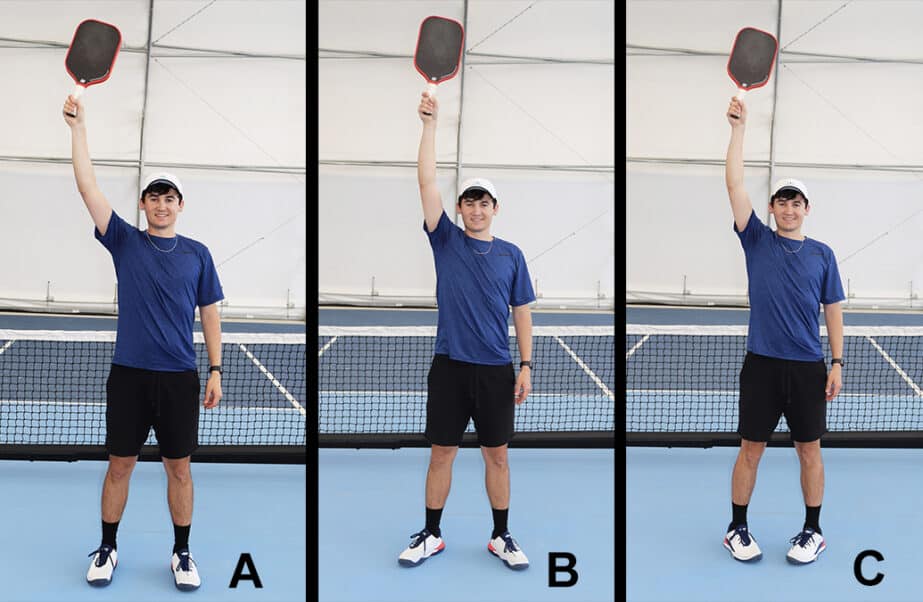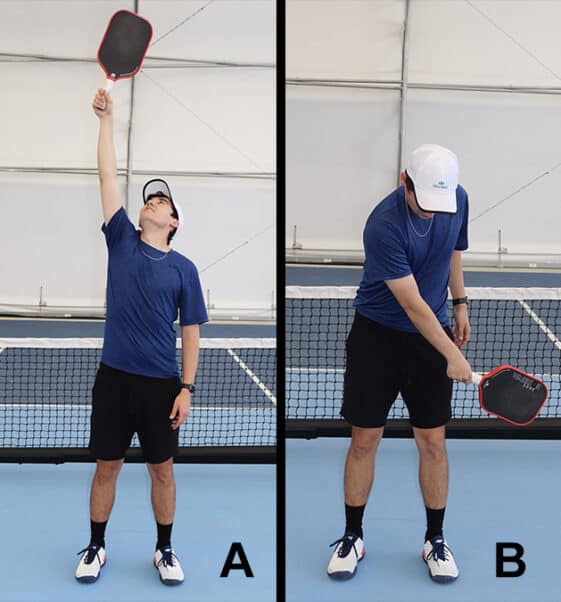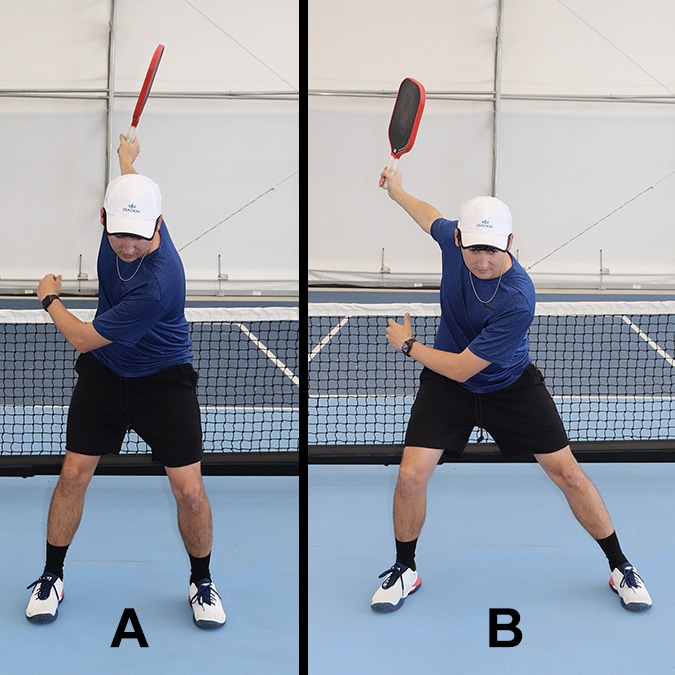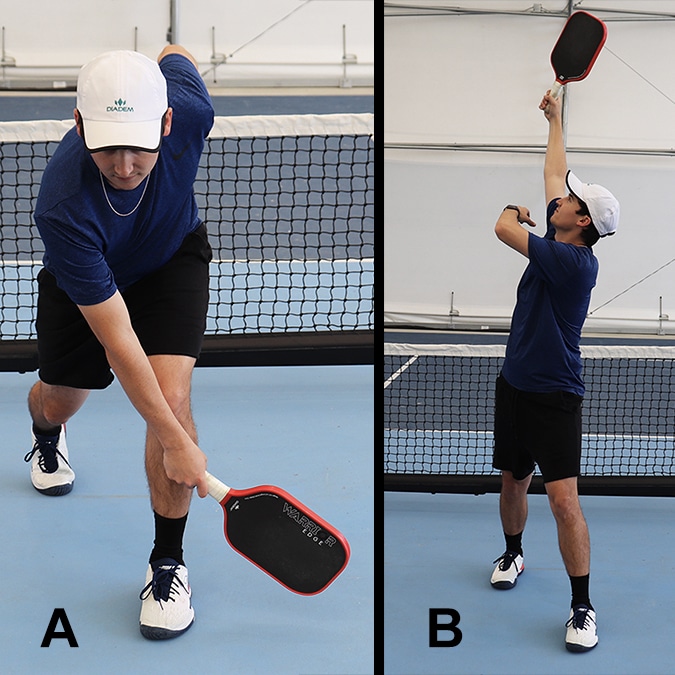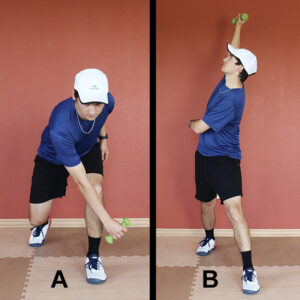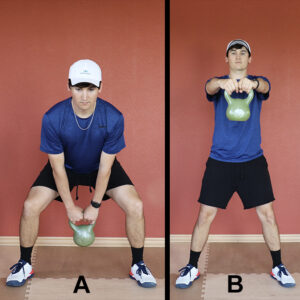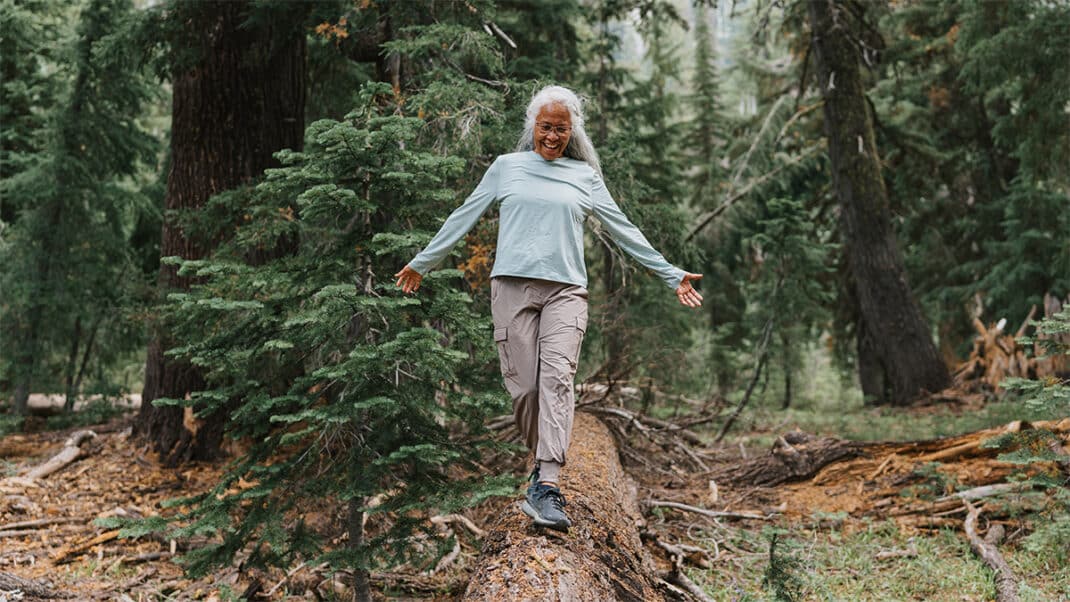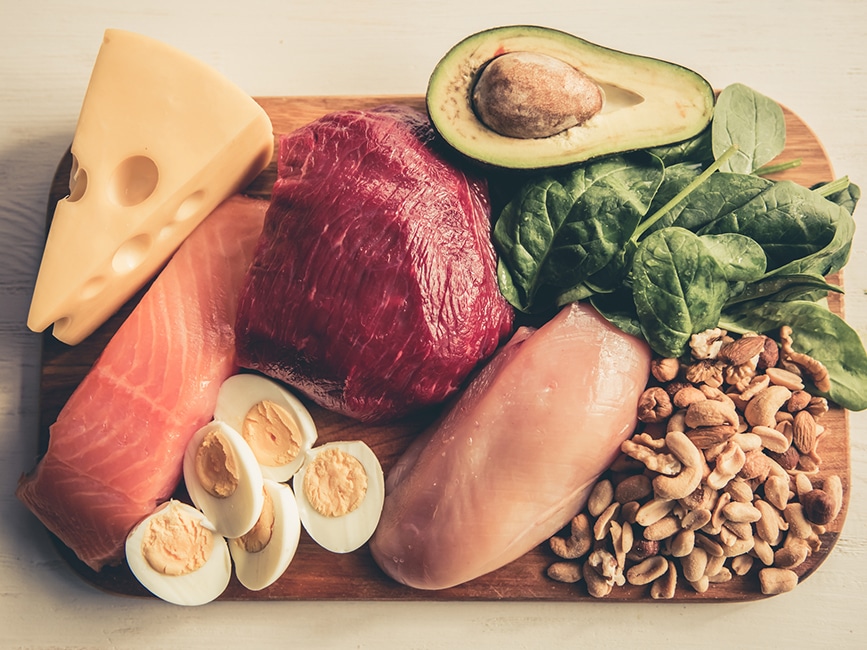Pickleball: Preventing Injuries and Enhancing Performance
Try this biomechanics-based warmup and dynamic exercise progressions.
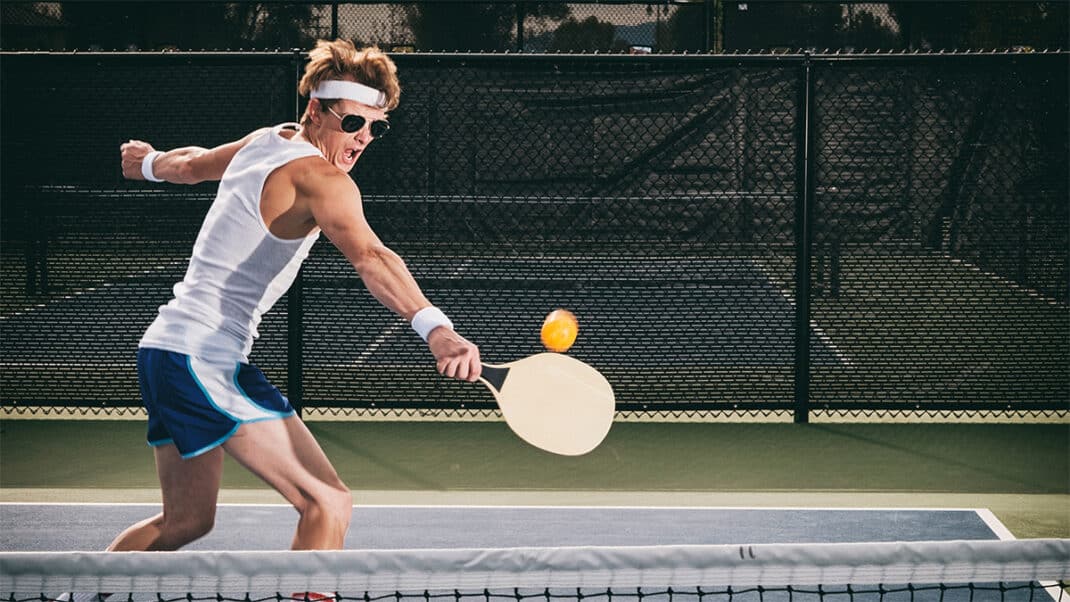
A serious game with a funny name, pickleball is the fastest growing sport in the U.S. (DeMelo 2022). Described as a combination of tennis, badminton and pingpong, pickleball is played in a singles and doubles format, indoors and outdoors, making it a perfect year-round activity.
As the sport continues its meteoric rise in popularity, it’s increasingly important that personal trainers understand the biomechanics of this dynamic sport—and how to help safeguard clients from injury and enhance their performance when playing it. But first let’s look at why it can be such a good choice for your clients’ program by appreciating its many health and fitness benefits.
Benefits of Playing Pickleball
Pickleball is a fun, engaging and social activity. It also provides many health and fitness benefits:
- significantly contributes toward physical activity guidelines
- enhances movements required to perform activities of daily living
- improves lower body strength
- improves balance
- enhances hand-eye and neuromuscular coordination
- improves maximal oxygen uptake
- decreases blood pressure
- improves cholesterol
- increases energy
- improves mood
- enhances sense of well-being
- increases movement confidence
(Sources: Webber 2022; ACE 2018; DeMelo 2022; Wray et al. 2021; Lavine 2021.)
Biomechanics of Playing Pickleball
Understanding the key movements required to play pickleball will help you select appropriate corrective exercises for clients to reduce their potential for injury. It will also prove useful for choosing dynamic performance-enhancing exercises to progress clients’ workouts.
Groundstrokes
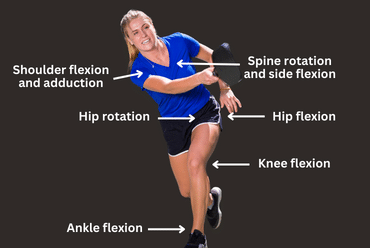
A groundstroke in pickleball is similar to a groundstroke in tennis. A forehand groundstroke is typically used to serve the ball underhand, while both forehand and backhand groundstrokes are used for returns, hitting approach shots and passing shots.
There are many elements the body must coordinate to perform a groundstroke movement. A moderate degree of hip and spine rotation is necessary to turn the torso quickly over the legs during the backswing and follow-through, and the arms and shoulders need to be able to move in multiple directions to swing the paddle back and forth (Figure 1). The ankles, knees and hips need to bend (flexion) to a moderate degree to help maintain balance, swing the paddle and enable the transfer of weight during the shot. Additionally, the spine needs to be able to bend forward and side-to-side to adjust to varying body positions and techniques.
Dinks and Volleys

Dinks and volleys are used once the player has progressed forward on the court to the kitchen line (an area close to the net). These types of shots require the player to move quickly from side to side to intercept the ball as well as to bend down low to return shots that are below the height of the net (Figure 2).
The quick, side-to-side lunging and squatting movements characteristic of dinks and volleys require the ankles, knees and hips to bend (flex) substantially. The lateral movements and rapid direction changes also require the hips to be able to abduct and adduct (move toward and away from the midline of the body) and rotate along with the ankles. In addition to the ankles, knees, and hips bending, the spine must also be able to bend forward (flex), move in rotation, and from side-to-side. Similar to groundstrokes, the arms and shoulders must be able to move in multiple planes to position the paddle.
Overhead Smashes

An overhead smash is used when a player lobs the ball over the head of their opponent, forcing the opponent to reach their paddle over their head to return the ball. While this shot is not overly common in pickleball, you should understand the movement mechanics so you can help clients avoid potential injuries when performing it. The reaching-up motion of an overhead smash requires the whole body to straighten or extend (including the ankles, knees, hips and spine) (Figure 3). This is very different to all of the other movements in pickleball which revolve around bending, rather than straightening, of the hips, knees and ankles.
Movement Summary
In short, a person must be able to do all the following movements in order to play pickleball effectively:
- Move the arm and shoulder in all directions
- Rotate, bend and straighten (extend) the spine
- Bend, rotate and move the hips in and out (adduction/abduction)
- Bend the knees
- Bend and rotate the ankles
Ensuring that clients can execute these movements will increase their enjoyment of the sport and help safeguard them from potential injuries.
See also: Spotting and Fixing Flaws in Walking Biomechanics
Common Pickleball Injuries and Causes
According to Greiner (2019), some of the most common injuries related to pickleball involve strains and tears of the soft tissues of the knees, lower back, feet and ankles, and shoulders.
Knee. Strains and tears to the lateral and medial collateral ligaments, which are on either side of the knee, are one of the most common types of pickleball injuries (Greiner 2019). This is because the knees (which sit between the ankles and hips) do not possess the same movement capabilities of those two other areas. Therefore, if the ankles and/or hips lack mobility, the knees become susceptible to pain and injury (Price 2018).
Lower back. Strains to the muscles of the lower back also commonly occur in pickleball. These muscles typically overwork during pickleball play and can become injured when required hip movements—such as bending, rotating and adduction/abduction—are lacking (Price 2018; Price 2014a).
Foot and ankle. When large lower-body muscles (e.g., calf muscles, quadriceps, hamstrings, glutes, adductors and abductors) are not working effectively to decelerate the body when it moves forward, backward and side to side, the stress generated by those movements transfers to the connective tissue instead and can cause injuries to tissues such as the Achilles tendons and plantar fascia (Price & Bratcher 2019).
Shoulder. Rotator cuff strains and tearsare another injury commonly experienced by pickleball players (Greiner 2019). Such injuries are typically caused by the inability of the arm to rotate effectively in the shoulder (glenohumeral joint) (Price 2014b).
Help Keep Clients Injury-Free and Performing Well
As increasing numbers of people take up pickleball, it is important that you understand the key movements required for this popular sport. This information will ensure you select appropriate corrective exercises to help avoid injury as well as design performance-enhancing exercises to improve your clients’ playing performance.
See also: Sports Participation and Longevity
Pickleball Problem Prevention
You can help clients prepare the body for play and reduce the risk of injury on the court with a warmup designed specifically to mobilize those areas required for pickleball (Walker 2018). (See “Pickleball Warmup Protocol,” below.) You can also use progressions of several of the warmup moves (adding weight or difficulty, for example) to enhance performance on the court. (See “Pickleball Performance-Enhancing Program,” below).
Pickleball Warmup Protocol
Perform the following warmup strategies in the order listed:
1. Begin with a walk or similar low-impact activity to increase general blood supply.
2. Perform a series of self-myofascial release techniques on the major muscles of the lower body, trunk, shoulders and arms.
3. Perform the mobility exercises in the “Pickleball Warmup Program” shown below.
Pickleball Warmup Program
First, some pro tips:
- Throughout the movements described here, the pickleball paddle should be held in the moving hand to provide resistance, mimic game play and help limber up the forearm and hand.
- The exerciser will perform the movements with both arms, even if they typically use their dominant arm for game play.
Credit: Photos printed with permission of The BioMechanics.
Backward Arm Circles
The momentum of the arms in this exercise transfers movement throughout the body to help mobilize the shoulder girdle, ankles and hips.
- Stand with feet hip-width apart.
- Hold the paddle in the right hand, arm extended straight but elbow not locked.
- Circle right arm backward 5 times (A).
- Repeat with the paddle in the left hand.
- Repeat steps 1 to 4 with toes turned out (B) (helps mobilize the ankles).
- Repeat steps 1 to 4 with toes turned in (C) (helps mobilize the hips).
Overhead Smash
This exercise utilizes the momentum of the arms to help mobilize the shoulder girdle and spine.
- Stand with feet hip-width apart.
- Make an overhead smash or throwing motion with the paddle (A) following through across the body (B).
- Perform 10 swings with the right arm and 10 swings with the left arm.
Pro tip: Look up when the paddle is directly overhead (A), and look down as the paddle passes the side of the body on follow through (B). Looking up helps extend the spine, while looking down helps flex it.
Side Overhead Reach
This exercise utilizes the momentum of the arms to help mobilize the shoulder girdle, ankles, hips and spine in the frontal plane (laterally).
- Stand with feet hip-width apart. Hold the paddle in the right hand.
- Reach the right arm overhead and sway the right hip to the right.
- Perform 10 times.
- Repeat on left side with left arm.
Torso Rotations
This exercise utilizes the momentum of the arms to help mobilize the shoulder girdle and enable the ankles, hips and torso to rotate better.
- Stand with feet slightly wider than shoulder-width apart and knees and hips bent slightly.
- Gently lean forward at the hips, keeping the spine straight. Swing arms back and forth across body 20 times (A).
- Next, assume a much wider stance and lunge from side to side while swinging the arms back and forth (B). Repeat 20 times.
Lunge to Reach
This exercise mobilizes the ankles, knees, hips, shoulder girdle and spine.
- Stand with left foot forward and right foot back in a split stance (or lunging position) with paddle in right hand.
- Lunge down and forward, reaching the paddle toward the ground on the outside of the left foot (A).
- Return to standing position, rotating torso backward while reaching right arm up and behind head (B).
- Repeat 10 times on right side and 10 times with left leg forward.
Squats
This exercise mobilizes the ankles, knees, hips, shoulder girdle and spine.
- Stand with feet hip-width apart and squat down, keeping arms up with elbows bent to approximately 90°. Repeat 10 times (A).
- Progress by incorporating a right arm reach across the body (B) or out to the side (C), alternating with each squat.
Pro tip: Lifting the arms (step 1, image A) helps keep the torso upright.
Pickleball Performance-Enhancing Program
You can also utilize the warmup routine as movement preparation for more dynamic performance-enhancing exercises. The “Pickleball Performance-Enhancing Program” teaches you how to add more dynamic movement to the torso rotation, lunge to reach, and squat movements below to build strength, flexibility and stamina on the court.
Torso Rotations with Stability Ball
With one foot on a stability ball, perform a one-leg squat with the weight-bearing leg (A) as the non–weight-bearing leg rolls the stability ball out to the side (B). Progress the difficulty further by adding an arm reach to the squat/lunge motion (C).
Lunge to Reach With Hand Weights
Use a hand weight instead of a paddle when performing Lunge to Reach exercise.
Squat with Weight (Kettlebell Swing)
Use a kettlebell and swing it between the legs when squatting.
References
ACE (American Council on Exercise). 2018. ACE-sponsored research: Can pickleball help middle-aged and older adults get fit? Accessed March 23, 2023: acefitness.org/continuing-education/certified/august-2018/7053/ace-sponsored-research-can-pickleball-help-middle-aged-and-older-adults-get-fit/.
DeMelo, J. 2022. Why is pickleball so popular? The New York Times online. Accessed May 15, 2023: nytimes.com/2022/09/03/well/move/pickleball-popular-sport.html.
Greiner, N. 2019. Pickleball: Injury considerations in an increasingly popular sport. Missouri Medicine, 116 (6), 488–91.
Lavine, R.A. 2021. Physical and mental benefits of pickleball, with fun besides. Psychology Today online. Accessed May 15, 2023. psychologytoday.com/us/blog/neuro-behavioral-betterment/202112/physical-and-mental-benefits-pickleball-fun-besides.
Price, J. 2014a. Herniated discs: What can a fitness professional do to help? ACE ProSource. Accessed May 15, 2023: acefitness.org/continuing-education/prosource/june-2014/4840/herniated-discs-what-can-a-fitness-professional-do-to-help/.
Price, J. 2014b. Overcoming and eliminating rotator cuff injuries. ACE ProSource. Accessed May 15, 2023: acefitness.org/continuing-education/prosource/july-2014/4898/overcoming-and-eliminating-rotator-cuff-injuries/.
Price, J. 2018. The BioMechanics Method for Corrective Exercise. Champaign, IL: Human Kinetics.
Price, J., & Bratcher, M. 2019. The BioMechanics Method Corrective Exercise Educational Program (2nd ed.). Belton, TX: The BioMechanics Press.
Walker, B. 2018. The Anatomy of Sports Injuries: Your Illustrated Guide to Prevention, Diagnosis, and Treatment (2nd ed.). Berkeley, CA: North Atlantic Books.
Webber, S., et al. 2022. Physical Activity Intensity of Singles and Doubles Pickleball in Older Adults. Journal of Aging and Physical Activity, 1–6.
Wray, P., et al. 2021. Pickleball for Inactive Mid-Life and Older Adults in Rural Utah: A Feasibility Study. International Journal of Environmental Research and Public Health, 18 (16): 8374.
Justin Price, MA
Justin Price, MA, is creator of the BioMechanics Method® Corrective Exercise Specialist (TBMM-CES) program, the fitness industry’s highest-rated CES credential, with trained professionals in 80 countries. He is also the author of several books, including The BioMechanics Method for Corrective Exercise academic textbook, and he was awarded the 2006 IDEA Personal Trainer of the Year. He has served as a subject matter expert for numerous brands and media organizations including ACE, TRX® and BOSU®; the BBC, Discovery Health and MSNBC; Arthritis Today, Men’s Health, Newsweek, Time, WebMD and Tennis; and Los Angeles Times, The New York Times and Wall Street Journal. Learn more about The BioMechanics Method®
